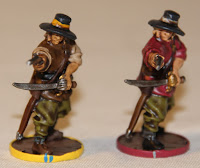So, we have a major scrum of different units, from all kinds of nations, and want to differentiate them. How to do it? Could you perhaps just remember what unit each sculpt is? They are surprisingly distinctive, after all?
Sorry, no luck. In the image above, there are two English Sea Dogs (to the left), two French Marins (in the middle) and two Spanish Marineros (to the right).
 |
| English Sea Dog and French Marin. Note: same sculpt. |
 |
| French marin and Spanish Marinero. Note: same sculpt. |
 |
| Spanish Marinero and English Sea Dog. Note: once again, same sculpt. |
Instead, note how the color of the base rims correspond to which nationalities are present? Congratulations, you've found step one. The color of the base tells you which nation the unit is from.
Yellow for Spanish units, red for English units, and blue for French units. So, if one were looking for Spanish units, look for the yellow base rims.
Now, once we have all the Spanish, how do we differentiate them? Look at the tiny markings on the (yellow) base rims. Specifically, notice how they're different colors? Red, blue and green (although the green is surprisingly similar to the blue at more normal light levels). That tells you what kind of unit it is.
All Lanceros (all one, in this image) have green markings, all Milicianos have red, and all Marineros are blue. The commander have the same markings as the nationality color (so, solid yellow for the Spanish).Once I get Milicianos Indios, they will get brown markings.
But what if you have several units of the same? That is where the markings themselves come in. The first unit will have a single slash on each quarter of the base (each quarter, so that at least one marking is guaranteed to be visible, no matter where you're looking from), the second unit will have two markings, and so on.
Once sorted out, this is quite obvious. Thus, even if the two units happen to get close to each other, a quick glance will still tell them apart
Same with the Marineros, one, two or three slashes depedning on whether it's unit 1, 2 or 3.
Even units 2 and 3 are surprisingly easy to tell apart.
Same thing with the English, this time with dark red bases.
Light blue for the Sea Dogs, one or two slashes for the different units.
Dark yellow for the Freebooters.
And no markings/dark red slashes for the commander.
English Militia will most likely get white slashes, assuming this doesn't make them hard to differentiate from the Freebooters or Sea Dogs.
French get blue bases.
Boucaniers have green slashes (bordered with white, since the contrast between blue and green was not sufficient under nomal light conditions).
Flibustiers get yellow slashes (unit 2 and unit 1, as you should be able to tell by now)
And Marins are light blue over the normal blue, in an attempt to have some comonality between similar units between different nations.
French Militia will get either white or light grey slashes, whichever makes them less likely to be confused with other units.
Finally, something a bit more special: the Storming Party.
These very models can be fielded as either English Forlorn Hope or French Les Enfants Perdue. Due to this crisis of personality, and by dint of being an elite unit, they get special bases, striped between (roughly) equal parts French blue and English red. I don't think I will ever want more than one unit, they're too expensive and it's better to have one unit of 8 than two units of 4, thus differentiating between different units of these will not be a problem.
/Fool out, back to paint some more.


















Inga kommentarer:
Skicka en kommentar